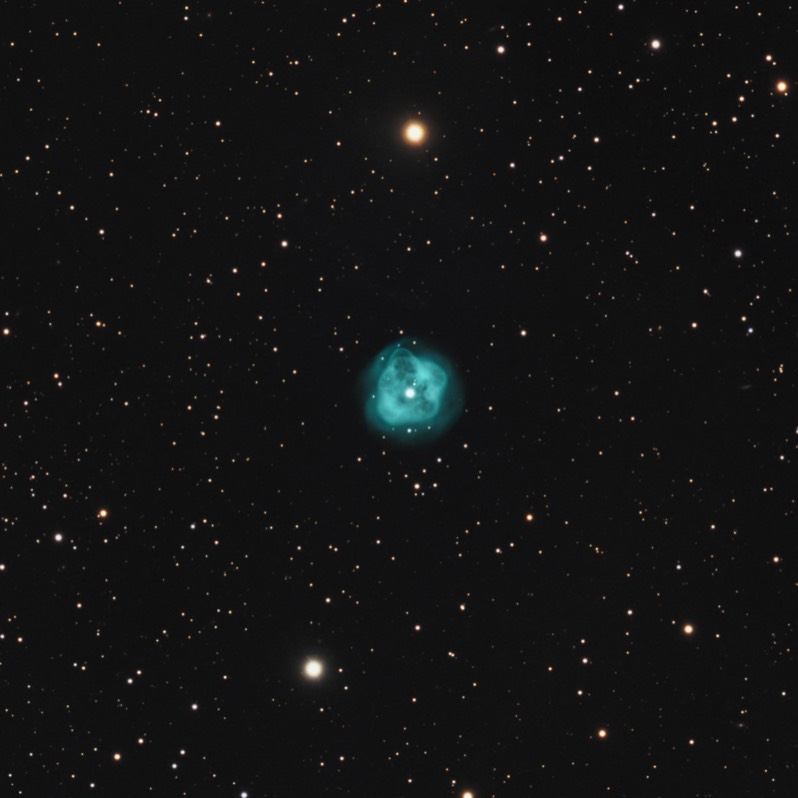The Crystal Ball Nebula, NGC 1514 in Taurus
Published 24 Dec 2020
About this object
NGC 1514 is a dim planetary nebula in the constellation Taurus. It goes by several names: PK165-15.1, PN G165-15.2, ARO 21 and the Crystal Ball nebula. NGC 1514 is fairly dim at magnitude 10.8 and is 2.2x2 arc min in size. It lies roughly 2,400 light years distant and has a diameter of 1.6 light years. Wiki: https://en.wikipedia.org/wiki/NGC_1514. NGC 1514 also sits within a large area of dust. The dust is faint but you can probably see it in the full un cropped image link above. I purposely didn't try to enhance the dust much but did include this inverse image where the dust shows up as darker areas of the background and less dusty or dust free areas are whitish. The stars are also inverted so they are dark. In the full uncropped field of view are a good amount of faint PGC galaxies too. Here is an annotated version labeling them. It's fun to look at the full 60 mega pixel image and check out these small galaxies.
This image was taken between 8 Sep and 19 Nov 20 using my Stellarvue SVX152T 6" refractor and ZWO ASI 6200 camera through Luminance, Red, Green, Blue, HII and OIII filters. The nebula glows very bright in doubly ionized oxygen (OIII) giving it its blue/green color. The image was taken using 2x2 binning and then drizzled 2X to the full resolution of a 1x1 unbinned image. Image scale is .64"/pixel. Processing was done in PixInsight with a few final tweaks in PS CC.
NGC 1514 is a dim planetary nebula in the constellation Taurus. It goes by several names: PK165-15.1, PN G165-15.2, ARO 21 and the Crystal Ball nebula. NGC 1514 is fairly dim at magnitude 10.8 and is 2.2x2 arc min in size. It lies roughly 2,400 light years distant and has a diameter of 1.6 light years. Wiki: https://en.wikipedia.org/wiki/NGC_1514. NGC 1514 also sits within a large area of dust. The dust is faint but you can probably see it in the full un cropped image link above. I purposely didn't try to enhance the dust much but did include this inverse image where the dust shows up as darker areas of the background and less dusty or dust free areas are whitish. The stars are also inverted so they are dark. In the full uncropped field of view are a good amount of faint PGC galaxies too. Here is an annotated version labeling them. It's fun to look at the full 60 mega pixel image and check out these small galaxies.
This image was taken between 8 Sep and 19 Nov 20 using my Stellarvue SVX152T 6" refractor and ZWO ASI 6200 camera through Luminance, Red, Green, Blue, HII and OIII filters. The nebula glows very bright in doubly ionized oxygen (OIII) giving it its blue/green color. The image was taken using 2x2 binning and then drizzled 2X to the full resolution of a 1x1 unbinned image. Image scale is .64"/pixel. Processing was done in PixInsight with a few final tweaks in PS CC.
Image Details
- Optics : Stellarvue SVX 152 refractor @f8 1200mm FL
- Mount: Paramount MYT
- Camera: ZWO ASI6200
- Filters: Chroma 50mm LRGBOIII, Astrodon 50mm Ha
- Exposure (min): LRGBHaOIII 108:194:137:240:543 20.5hrs, 2x2 binning
- Camera/Mount Control: The Sky X, Voyager
- Guiding: StarlightXpress Lodestar X2
- Processing: PixInsight 1.8, PS CC
- Location: Stark Bayou Observatory, Ocean Springs, MS
- Sky: Typical SQM 19.6-20.1, Bortle 5, Suburban
- Date: 8 Sep-19 Nov 2020







